|
BIOGRAPHIES
Source:
ILLUSTRATED
ATLAS & HISTORY
of
HARRISON COUNTY, INDIANA
containing maps of
Villages, Cities and Townships
of the County,
Maps of State, United States and World.
County Statistics, Biographies and History of the County
Portraits of Public and Leading Citizens
Compiled and Published by
F. A. Bulleit
Cordon, Ind.
1906
Found at: https://indianamemory.contentdm.oclc.org/digital/collection/p15078coll8/id/3890
<
CLICK HERE to GO to LIST of TABLES of CONTENTS and BIOGRAPHICAL
INDEXES >
|
Pg.
41 - Industrial Review, Biographies and
Portraits of Leading Citizens. |
|
 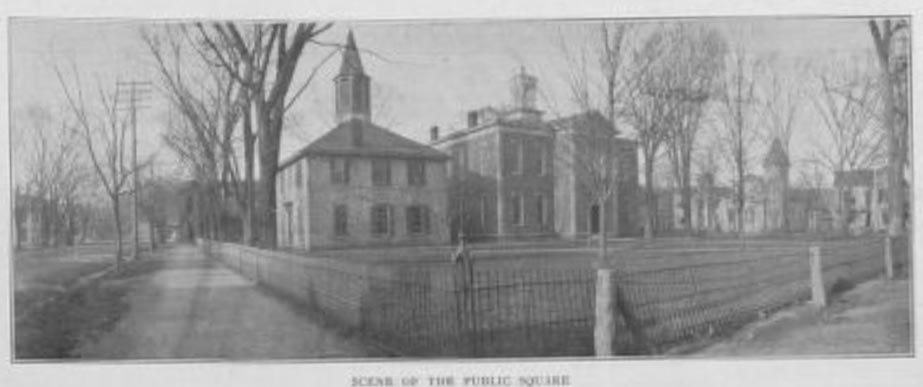 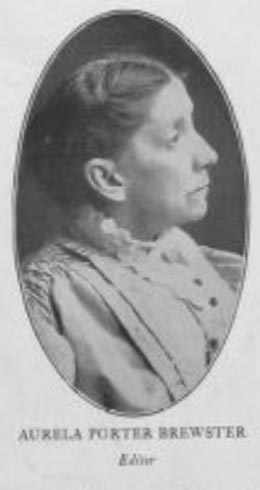
HISTORY OF HARRISON COUNTY
By Aurela Porter Brewster |
The settlement of Harrison
County by white men dates as far back as 1800 when
Indiana was erected into a territory. Adventurous
spirits weary of the worn out farms of the older states
set out, hunting new homes and fresher fields. In
ox wagons, on pioneers pressed forward with eyes fixed
ever on the Western Star. The Ohio River furnished
transportation for many. They floated down on
rafts or flat boats, and landing on its lonely shores,
they struggled with the Indian for a foothold and
prevailed. It is the old story of men with brawny
arms and resolute hearts and of women worthy to stand
beside them in the stern battle against rude and
uncultivated nature.
It is certain that Daniel Boone and his brothers
crossed the Ohio into the Southern border of the State
in search for bear and deer and found with them the
panther and the Indian. Other restless hunters
came with them or followed in their wake - venturing
only at first to cross the river with rifle in hand; at
another time halting long enough to plant a little corn
in some fertile valley; then, with gun in easy reach to
build a little log cabin and finally with stout hearts
and hopes to bring wife and children and light the fires
of home.
Ferries were early established at Brinley's and at
Mauckport.
Ripperdan's Valley, three miles long and from
one to two miles wide, offered special inducements to
the pioneer, and here, in June, 1807, came
John
Ripperdan from Danville, Ky., his wife riding beside
him with a feather bed for a saddle. This valley
produces good crops after nearly a hundred years of
cultivation, some fields at present yielding 25 to 40
bushels of wheat per acre. John
Ripperdan's descendants linger around this valley
yet. He was the maternal grandfather of
John P.
Sonner whose father, Capt. William
Sonner, also emigrated early from Virginia.
In 1807 Ephraim Fleshman came to Harrison
County settling in Heth Township upon what is now known
as the John Frank land and was buried there,
probably the first person to die in the county.
John Frank moved from Salisbury, North Carolina, and
brought his family in wagons. He brought several
chests containing apple, peach and pear seeds and a
small quantity of peach brandy. Jacob Lopp
came in 1808.
Wolves were especially troublesome in the new
settlement and John Simler, Sen., built a pen in
which to catch them. Wolf Knob
receives its name from the great number of wolves that
congregated there to howl at night.
About six miles back from the Ohio River, in Grassy
Valley, Squire Boone (a brother of
Daniel Boone) with his sons, Isaiah,
Enoch, Moses and Jonathan and five nephews
built their cabin and then began to cultivate the land.
This was in 1802. Afterwards R. N. Heth
bought the claim. In 1802 or perhaps earlier
William Applegate came from Pennsylvania and
Henry Watson from Kentucky.
In 1798 John Hudson, grandfather of
W. H. H. and
James Hudson, came into the county from Shenandoah
Valley, Va., having lived for a short time in Kentucky.
He crossed at Louisville when there was but a single
house on the Indiana side of the river at New Albany.
He entered much land all around where Elizabeth now
stands.
Thomas Stevens, great grandfather of
Warder
and Charles Stevens, settled in Pleasant Valley,
among the first in the county. James Armstrong
settled just below Lanesville in 1800 and had his first
sight of roasting ears when he saw the Indians there
holding them before the fire to roast.
These are the names of only a few of the stalwart men
who, here and there all over the county, opened up the
wilderness to civilization. There were many more
and their descendants are with us to this day.
They can relate incidents and family anecdotes that
would fill a volume.
Harrison County was the fourth formed in the State.
Knox, Clark and Dearborn were earlier. It was
organized in 1809 an d named after Gen. W. H.
Harrison. The first term of the Court of
Common Pleas was held in that year with
Moses Boone,
Patrick Sheilds and
John George Pfrimmer,
Associate Judges. The first sheriff of the county
was Spier Spencer who was appointed by the
territorial government. Dennis Pennington
was foreman of the first grand jury. The other
members were John Smith, William Nance, George
Gresham, Reuben Wright, Tice Light, Henry Rice, George
Crutchfield, John Livanks, Jacob Conrad, Eli Wright,
William Vest, Edward Smith, Lawrence Black, John Smith,
Sr., William Branham, Isaac Richardson, John Hickman,
Lawrence Bell, William Pennington and
William
Sands.
WILLIAM HENRY HARRISON.
William Henry Harrison,
whose memory permeates the whole history of this county,
was born in Berkeley, Virginia, Feb. 9th, 1773. He
entered the army early, was appointed secretary of the
North Western Territory and on the thirteenth of May,
1800, he was appointed Governor of Indiana Territory.
On the tenth of January following he arrived at |
Vincennes and took possession of his
office. He remained in control of the executive
department of the Territory until September, 1812, when
he was appointed a Brigadier General and assigned to the
command of the northwestern frontier.
Secretary John Gibson became acting Governor and
on the Twelfth of March, 1813, prorogued the legislature
at Vincennes and directed it to reassemble at Corydon on
the first Monday of the next December. All the
records and offices of the Territorial government were
in the meantime moved to Corydon.
General Harrison's
career as Territorial Governor was an eventful one, yet
he found time to perform the duties of a private
citizen. In 1807 he entered the lands known as the
Wilson Mills property in Harrison County and built a
grist mill for the manufacture of flour and meal.
He had intended making this place his home and had laid
the foundation of a house but his father-in-law died
leaving him property at North Bend, and |
the appointed time found his corn ground and in his
wagon. He started off without delay and none of
the other customers knew that General Harrison
had kept his mill going all night rather than have
a friend take such a long journey in vein.
THOMAS POSEY.
Thomas Posey,
the last Governor of Indiana Territory, was born in
Virginia on the banks of the Potomac, July 9th 1750.
He succeeded General Harrison as Governor of
Indiana Territory on March third, 1813, and delivered
his first message to the legislature assembled in
Corydon on the sixth of December. He was
sixty-three years old and broken in health. He did
not like to live in Corydon and preferred
Jeffersonville. |
|
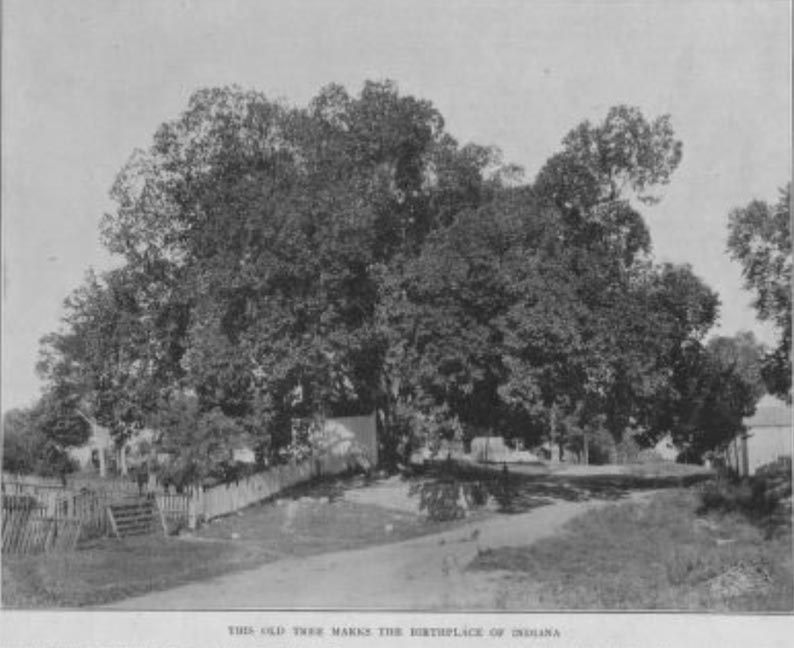
THIS OLD TREE MARKS THE BIRTHPLACE OF INDIANA |
he changed his purpose of settling here. His
family lived at Vincennes during this time.
He was essentially a man of the people. The
writer of this article was awe-struck at hearing one of
the old pioneers, in the course of an interview, speak
of the honored ninth President of the United States as "Bill
Harrison," but this familiarity gives a clue to his
character and reveals how he was enshrined in the
affections of the people.
Many anecdotes are told of his kindness of heart, the
homely trains of his character and the simplicity of his
tastes. At one time a friend living at quite a
distance, came to the mill with his grist to grind.
Others were before him with their orders and of course
first come first served was the order of the business.
General Harrison was loath to send him home so he
bade him put up his team, go upstairs quietly to bed and
at 3 o'clock come to the mill prepared to start home.
this he did and at |
so as to be near his physician in Louisville. He
moved his residence there during a session of the
legislature and his messages and orders were carried
between the two places by his private secretary,
Allen D. Thom. The delay caused by all this
entailed an extra expense of fifty dollars a day and he
received a rebuke from both houses. Governor
Posey was a Christian gentleman and a member of the
Presbyterian church. He did much toward the
advancement of religion among the poor and needy of the
Territory. He died in Illinois soon after the
close of his term as Governor.
THE CONSTITUTION.
In May, 1816, delegates were
elected to make a State Constitution and met at Corydon
on June 10th, 1816, and performed the work during a
session of nineteen days. This constitution was
signed on the twenty- |
|
Pg. 42 - Industrial Review,
Biographies and Portraits of Leading Citizens. |
|
ninth by Jonathan Jennings, President, and
William Hendricks, Secretary. The delegates
from Harrison County who signed it were Dennis
Pennington, David Floyd, Daniel C. Lane, John Boone
and Patrick Shields.
THE
FIRST ELECTION
On the first Monday of
August following officers were elected for the new
State. Indiana was admitted into the Union in
December, 1816. The population of Harrison County
in 1815 was, white males twenty-one years or over, 1056,
and a total of 6,975. The county was entitled to
one Senator and three Representatives. The first
Senator was Dennis Pennington, the first
Representatives were David Floyd, Jacob Zenor and
John Boone. Judge Davis Floyd in
1801 was Recorder of Clark County
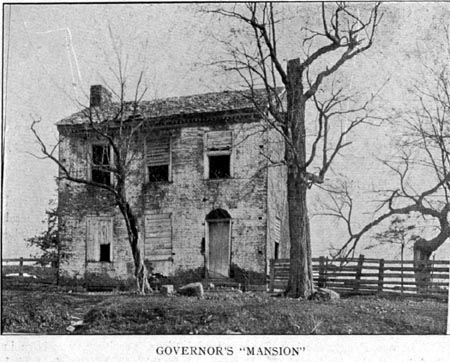
GOVERNOR'S "MANSION"
before Harrison was formed from it. He was an
admirer of Aaron Burr and came near being led off
by that artful traitor. Floyd was suspected
of implication in the Burr conspiracy, was tried
and convicted for which he received three hours
imprisonment only. At the first State election in
1816 Governor Posey was a candidate for Governor
but was beaten by Jonathan Jennings, President of
the convention and late delegate to Congress, by a vote
of 5,211 to Posey's 3,936.
The majority of the early
settlers came from slaveholding States. They had
felt the blight of slavery and came seeking freedom in
its widest sense, and brought with them their dislike to
human bondage. Jennings had been a
leader of the free state party since his entrance into
public life while Posey, a Virginian by birth,
was considered the pro-slavery candidate.
The pro-slavery men of the Territory kept up their
organization, hoping to repeal that clause in the
Ordinance of 1787 which prohibited slavery.
It is hard to realize that slaves were ever held in
Indiana, yet the first fight for Governor was made on
this issue. Slaves were held here as late as 1830.
In 1820 there still remained one hundred ninety slaves
in Indiana. The legal right to hold slaves came to
an end in 1830 but the census of 1840 disclosed the fact
that there were still three slaves in Indiana.
Many hundreds were brought here and liberated.
Pal Mitchem, a gentleman from Virginia, came to
Corydon at a very early day, bringing with him a number
of slaves whom he set free. Their descendants have
lived here since - Jonathan Mitchem, the present
driver of the mail wagon from Corydon to Elizabeth,
being one of them.
EDWARD SMITH
In 1806 Edward Smith
settled on the land now owned by Edward O'Connor
and the Harrison County Fair Association, and on the
green knoll near the spring he built his cabin. He
was born in England and came to America as a soldier in
1774. In the spring of 1807 he brought two of his
daughters and one of his sons to his home. He
raised a crop

THE BREWSTER HOME of corn and in the fall he
brought his whole family. Mr. Smith was a
member of the first grand jury of the county and his
name is often seen in the old records. He has
numerous descendants now living in the county having had
three sons, John, James and Samuel, and
six daughters. The daughters all married and their
names became as follows: Jennie Beeman, Polly
Highfill, Sallie French, Rachel Black, Isabel Felts
and Nancy Highfill. |
He was a
deserter from the British army and it is not certainly
known that he ever joined the American army,
nevertheless the Daughters of the Revolution,
represented by one of his descendants, have raised a
monument to his memory. He lies buried on the hill
just south of town. The exact spot could not be
found, so it was thought best to place this monument,
inscribed with his name and those of his family, in the
cemetery at Mt. Zion, near Mauckport, where his wife is
buried. He died at Corydon in 1828.
Interesting anecdotes are told of this family in
connection with General Harrison. At one
time after riding through the mud from Vincennes,
General Harrison stopped at night as usual at Mr.
Smith's. His clothes were dirty and his socks
were not only dirty but worn at the toes, and he asked
one of the girls to wash a pair for him. She cut
off the worn toes and by the light of a lard lamp
knitted new toes and had them ready to put on in the
morning. Governor Harrison did not forget
this kindness and when next he came through he bought
the young lady a five dollar shawl as a token of his
thanks. At this time he was accompanied by a
single aid, Lieutenant Randolph, and they both
slept in the gallery. This gallery is elsewhere
described.
CAPTAIN SPIER SPENCER
In 1811 war
with England seemed almost inevitable, and the British
agent for Indian affairs was doing all in his power to
secure the support of the Indians. A great Indian
confederacy was formed under Tecumseh and his
brother, the Prophet, who with a number of his
followers settled near the mouth of the
Keth-tippe-ce-nunk meaning Buffalo Fish and now called
Tippecanoe. Governor Harrison exhausted
every endeavor to maintain peace and at last under
instructions of the President resorted to military
measures and gathered an army to break up the assembly
of hostile Indians. Spier Spencer
lived in Corydon in a large double log house on Oak
Street. He came from Kentucky to Vincennes and
from there to Corydon in 1809 and was the first sheriff
of the county. Spencer moved his goods from
Vincennes in a pirogue down the Wabash to its mouth and
then up the Ohio river to Morvin. His family had
come overland and were stopping at General Harrison's
Mills on Blue River.
He organized a military company called "the Yellow
Jacks" for the Indian war. With Lieutenants
Berry and Richard McMahan, Ensign John
Tipton and his company he started on the tenth of
September, 1811, on the campaign that ended in the
battle of Tippecanoe November seventh, 1811. In
this battle Captain Spencer was badly wounded and
his men
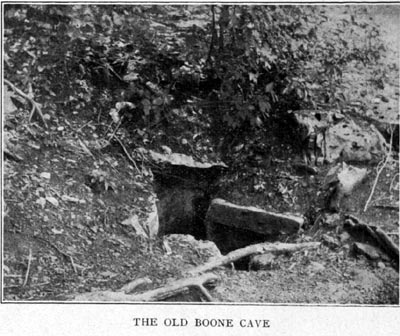
THE OLD BOONE CAVE
(among whom was Samuel Pfrimmer,
father of Major J. S. Pfrimmer) were carrying him
off the field when a second shot entered his shoulder
and ended his life. In his company from Harrison
County were Robert Biggs, Jonathan Wright, Daniel
Bell, Philip Bell, John Hughes, Elijah Hurst and
John or Jack Hurst.
Captain Spencer left a widow and five daughters.
These were Delilah wife of Dr. James B.
Slaughter, Nancy, wife of David Bell, Mathilda,
wife of John Tipton, Jane, Mrs. Davis, and
Sarah, wife of George P. R. Wilson. His
two sons, Captain George Spencer and
Lieutenant James Spencer, were both educated at West
Point and afterwards lived military lives.
Lieutenant James Spencer became involved in a duel
in which he was wounded and in which he shot off his
opponent's cravat. Captain Spier Spencer
had kept hotel and his widow continued it. She
afterwards married William Boone and together
they kept the old "Billy Boone Tavern," so famous
in its day.
GENERAL JOHN TIPTON.
John
Tipton, afterwards General Tipton, soldier
and statesman, came to Harrison County in 1807 and
settled near Brinley's Ferry on the Ohio River.
At the first election under the State Constitution
Tipton was elected sheriff of the county and the
records show that in the July term of court 1817 he and
his deputy, Hiram C. Boone, were fined one dollar
each for not keeping order in the court room. His
father had been killed by the Indians and he felt it a
duty to avenge this death and many an Indian "bit and
dust" at command of his rifle.
Tipton kept a journal of the Tippecanoe campaign
and it closes as follows:
"Sunday a cloudy and rainy morning. We moved
early. Came to Corydon at half past ten.
I staid two hours and half; took breakfast; moved up to
Coonrod's; found my Lt. and sick man. Staid
2 hours; had my horse fed; got some whiskey; met one of
my neighbors. Moved again and at 2 o'clock got
safe home after a campaign of 74 days. John
Tipton."
He says he was with
Spencer's company of forty-seven riflemen besides
officers and Captain R. M. Heath with twenty-two
men.
An election for officers was held after the battle when
Tipton was elected Captain, Samuel Flanagan
First Lieutenant, Jacob Zenor Second
|
Lieutenant and Philip Bell Ensign.
Tipton rose by regular graduation until he became
a Brigadier General in the service of the State.
He donated to the State the beautiful battle ground of
Tippecanoe. He died at Logansport, April seventh,
1839, and was buried with military honors.
COLONEL LEWIS JORDAN
Colonel
Lewis Jordan was born in Shenandoah county,
Virginia, on the fourteenth of March, 1792. He was
decidedly military in his tastes, and in the war of 1812
served in Captain Richard Proctor's company,
Seventh Regiment Virginia Volunteers. His father
was a Hessian soldier in the Revolutionary war who fell
in love with a pretty girl in Frederick, Maryland, and
married her after the war closed. Colonel
Jordan held
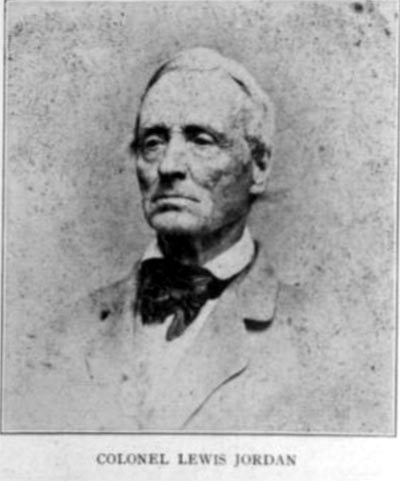
COLONEL LEWIS JORDAN
commissions in the Indiana Militia
bearing the signatures of six Indiana governors
commencing with Jonathan Jennings in 1822 and
ending with O. P. Morton in 1861.
In 1819 Colonel Jordan and his brother
Benjamin settled three miles south of Corydon on
land which has ever since remained in possession of
members of the Jordan family.
In 1828 he moved to Corydon
where he operated a tannery. In 1861 he was
appointed Colonel of the Sixth Regiment, Indiana Legion,
and was in command at the time of the Morgan
Raid. With only four hundred raw men with which to
oppose three thousand trained and experienced troops he
made such a brave resistance as to retard their progress
for several hours thus gaining time until more effective
help could be secured. He was twice Postmaster and
once Justice of the Pearce in Corydon. He died
July fifth, 1873.
THE CROSIER FAMILY
A party of
pilgrims composed of Dr. Adam Douglas,
Grandfather Crosier, Grandfather Stokoe,
Anthony Dodd and wife, Adam Dodd, Robert Crosier
and members of their families to the number of
twenty-eight left Ontario in New York, then called
Manhattan, on the seventh of February, 1816, their
destination being the Wabash district, then the farthest
limit west. These emigrants by walking and the
help of an ox-cart, made their way to Olean Point, the
headwaters of the Allegheny River. From there they
floated down the river in a broadhorn to Tobacco
Landing, reaching that place on the third of June.
There the health of Mrs. Crosier failed and,
leaving the river, they settled temporarily in Boone
Township and finding good land and good water concluded
to stay there instead attempting to go farther.
Uncle Sam was generous with his children who went out
to till his fields in the early morning hours of the
nation's day and gave them their homes cheap.
Mr. Crosier bought a thousand acres of land, paying
therefor from twelve and a half to twenty-five cents an
acre.
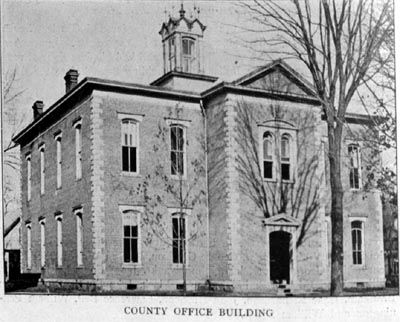
COUNTY OFFICE BUILDING
The
nearest postoffice was Corydon and Sarah Douglas,
afterwards Mrs. Adam Crosier, and an older sister
walked there once a month for the mail, wading Buck
Creek on the way. Half way they stopped at the
nearest neighbor's to rest. With the hospitality
of the times a lunch of corn bread and milk was given
them and while they ate, their host looked over the
county paper to see if a letter was advertised for them.
If they were so fortunate as to get one, they paid
twenty-five cents postage on it. |
|
Pg. 43 - Industrial Review,
Biographies and Portraits of Leading Citizens. |
|
Dr. Adam Douglas was a
man of culture and well versed in all the sciences of
the day. His daughter, Sarah, married
Adam Crosier, a man of ability and high standing
whose house was always full of the latest books and
periodicals. The Government at Washington depended
on him for weather records which he kept for years
before his death in 1887.
PATRICK
SHIELDS
Patrick Shields was
one of the first Judges of the Court of Common Pleas and
in every way one of the first men of the county.
He was born in Virginia in 1773. In 1800 he came
to Kentucky and in the spring of 1805 he moved to
Indiana and settled about two miles below the present
site of New Albany in a cane-brake on the banks of the
Ohio River. He, with his wife, three young
children and Sam, a negro slave, crossed
the river in a large pirogue. they had to take the
wheels off the wagons in
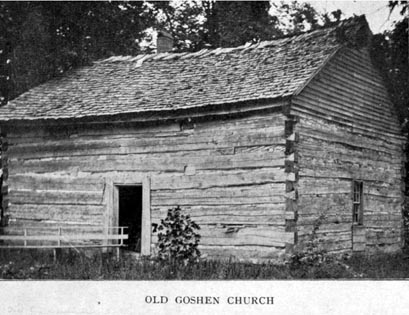
Old Goshen Church
crossing. After a time the river began to rise
and Mr. Shields determined to change his
location. With much difficulty they made their way
through the woods and cane-brakes down Little Indian
Creek and settled near where the town of Crandall now
stands.
It was an unbroken forest, infested by bears, deer and
other wild animals. Mrs. Shields father,
Mr. Nance, was a Presbyterian clergyman who lived
near the crossing place of the river. At Mr.
Shields' invitation he came over on a visit the
first Sunday that the family spent in their new home,
and preached the first sermon there in the dense woods
to an audience of six persons, three of whom only were
adults and capable of understanding what the preacher
said.
Wild game was the chief article of food the first year,
as the crop of corn and pumpkins was destroyed by frost.
Daniel Dean came a year afterwards and the
Greshams and Penningtons settled about a mile
east of where Lanesville now stands. Dennis
Pennington was fond of a joke. He used to
visit Mr. Shields' house and talk politics one
part of the night and religion the other.
Near Buck Creek were other settlers, among whom were
the Deckers, Smiths, Gwins and Calhouns,
and on Big Indian Creek at the same time were Isom
Stroud, Teeson Byrn and Daniel Stout.
THE BOONES
A glamour of romance hangs
over the name of Boone and everything pertaining
to their history is full of interest. Squire
Boone, a brother of Daniel and, like him a
famous hunter, settled in Harrison County in 1807 where
better game was to be found than on the Kentucky side.
His sons, Enoch, Isaiah, Moses and Jonathan
grew to be useful men in the community, uniting
patriotism with fervid piety. The Bible names
given
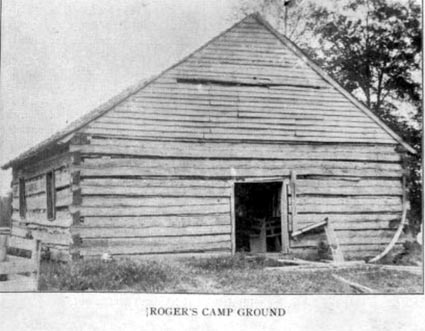
Rogers Camp Ground
to his sons show the religious tern of mind of the
old hunter and that his heart was given to God while he
made glad the wilderness and the solitary place.
His children followed in his footsteps. Isaiah
donated land in Corydon for the first Methodist church
and Moses was one of the builders of Old
Goshen where he and his neighbors worshipped eighty
years ago. Moses Boone was one of the three
earliest Judges of the Probate court.
Squire Boone was an excentric character but a
man of sterling worth. One one of his hunting
expeditions he was walking along a bluff of Buck Creek,
and discovered a small opening leading to a cave such as
might
|
have been used by some of the larger wild beasts.
A few miles farther on he saw hostile Indians
approaching and his only safety lay in flight. He
remembered the cave and sought its shelter. The
trailing vines hid the opening and he heard the Indians
tramping overhead in pursuit of him.
After this the cave became his favorite resort.
He engraved figures of birds and beasts upon the stones
in its walls, with hymns and Bible texts. The lagest
stone bears this inscription:
"Here I sit and sing my soul's
salvation,
And bless the God of my creation. |
Some of
these stones were afterwards placed as a foundation for
a mill which he built nearby on a stream which rushes in
a violent current from a cave higher up in the rocks.
Squire Boone directed that after his death his
body should be placed in a cavern that had sheltered him
in extremity. This was done and for years the body
of the giant pioneer lay undisturbed in this rocky tomb.
In time his skull and then his bones were carried away
by relic hunters and nothing now remains but the
inscriptions made by his own hand.
BRIGADIER-GENERAL PHILIP BARBOUR
Among the many
monuments in Cedar Hill Cemetery that might furnish
interesting records of past history we mention but one -
a solid piece of brick masonry covered with a heavy slab
of sandstone now grey with age. Brigadier
General Philip Barbour rode on horseback through
from Virginia to bring some business before the
legislature when Corydon was the capital of the State.
He contracted a severe cold on the way resulting in
pneumonia and causing his death.
He was an honored member of the fraternity of Masons
who attended him through his sickness and at his death
took charge of his remains. As there were no
facilities then for shipping the body home, the lodge
buried him here and placed the stone above his grave
which they have ever since kept in good repair. He
was at one time a candidate before the National
Convention for the office of Vice President of the
United States, and was associated with Alexander
Hamilton in the publication of "The Federalist.
THE GRESHAM FAMILY
Mrs. Sarah
Rumley, whose maiden name was Davis, was born
in Springfield, Kentucky, Sept. 5th, 1807. She
came with her parents to Harrison County when twelve
years of age. In 1825 she was married to
William Gresham and came as a bride to live in the
house near Lanesville where she died, Mar. 6, 1905.
In January, 1834, Mr. Gresham was killed while
performing his duty as Sheriff, an account of which is
given.
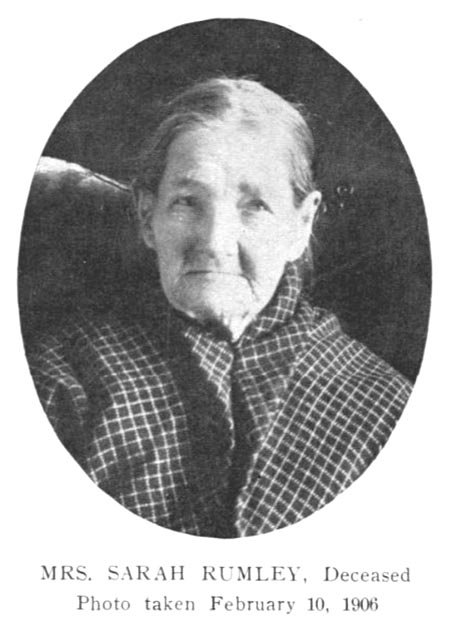 - -
MRS. SARAH RUMLEY, Deceased
Photo taken February 10, 1906
elsewhere. Thus after a married
life of ten years she was left a widow with five
children. She was afterward married to Nathan
Rumley. Her eldest son, Colonel Benjamin
Gresham, was a soldier of the Mexican and the Civil
War.
Colonel Gresham served through the Civil War.
Two daughters, Mrs. Smith, of St. Louis and
Miss Mead Gresham are still living.
PETER N. ZENOR
Peter N.
Zenor, a grandson of Peter McIntosh, one of
the earliest Probate judges of the county, was several
times a member of the Legislature. He was chosen a
member of the State Constitutional Convention of 1850.
During the war he was elected to the office of county
Commissioner to fill the vacancy made by the death of
Colonel Jacob Ferree who was killed in the Morgan
Raid. He spent his life on the farm on which he
was born June eleventh, 1820.
ALEXANDER HOCKADAY
Alexander
Hockaday was born in Danville, Kentucky, October,
1792, and died in Harrison County January fourth, 1894,
thus living to be over one hundred and one years of age.
He and his brother William came to Indiana to
live before New Albany was founded, locating on the
knobs just below the present site of New Albany.
Alexander was married there and moved to Blue
River township in Harrison County where he erected a
blacksmith shop. He reared a large family of
children, ten of whom are still living. His father
was a Revolutionary soldier.
T. C. SLAUGHTER
T. C.
Slaughter, son of Dr. James B. Slaughter and
his wife, Delilah Spencer, was born Nov. 16, 1820
and died in 1879. He was the first Auditor of the
county. In 1851 was editor of the Western Argus.
In 1860 was a member of the National Convention that
nominated Abraham Lincoln. In 1862 was
assessor of Internal revenue. In 1872 was Judge of
the Circuit Court and filled many other honorable places
in the County.
|
WALTER QUINTON GRESHAM.
Walter
Quinton Gresham was born at Lanesville, Indiana,
Mar. 17, 1832; died at Washington, D. C., May 28, 1895.
A politician, jurist, and general. He was admitted
to the bar in 1853, and joined the Union army at the
beginning of the Civil War, serving as a division
commander in Blair's corps before Atlanta, and
being brevetted major-general of volun-

WALTER QUINTON GRESHAM
teers March thirteenth, 1865. He
was United States judge for the district of Indiana
1869-82; was postmaster-general 1882-84; was secretary
of treasury in 1884; and became secretary of state in
Cleveland's cabinet in 1893. He is buried in
Arlington Cemetery.
COLONEL J. J. LEHMANOSKY
Colonel
J. J. Lehmanosky, of the Ninth Polish Lancers of the
Army of France, was in some respects the most remarkable
man who ever made Harrison County his home. He was
born in Warsaw, Poland, in 1773. He was a member
of an ancient Jewish family, but when a young man became
a Christian and a member of the Lutheran Church.
Leaving Poland after its ineffectual fight for freedom,
he went to France and drifted into the army. He
was identified with napoleon Bonaparte's fortunes
from the first and was a member of the Old Guard, the
very flower of the army, until the battle of Waterloo
put an end to Napoleon's career.
With many other officers of note he was thrown into
prison, but managed to escape and eventually found his
way to America. He was then only forty years old.
He lived in many eastern cities, among them Washington,
D. C., and was well known and honored every where.
Wearied out with his stormy life, he sought retirement
from the world and came west in 1833 settling in
Harrison County two miles and a half from Corydon.
His wife died and in 1837 he married Miss Lydia Seig,
sister of Monroe, Paul and John Q. A.
Seig. His son, Martin is living and
also his daughter Mrs. Nicholas Reising.
Colonel Lehmanosky
kept his Christian faith through all his years of
warfare and became a Lutheran preacher of great
influence. He lectured frequently on the incidents
of his life. He bore scores of wounds having
participated in two hundred and fourteen battles.
He died in Ohio over eighty years of age.
GEORGE P. R. WILSON
George P. R.
Wilson was a well known and popular citizen who
served eleven times in the Legislature. He was
noted for his oratorical powers
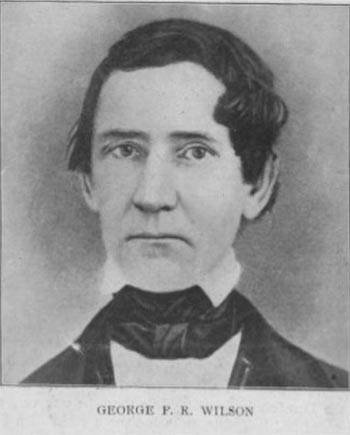
and on this account was chosen by his
party in 1845 to run against Robert Dale Owen for
Congress. He married Sarah, youngest
daughter of Captain Spier Spencer.
DAVID DEATRICK
David
Deatrick came from near Staunton, Virginia in 1816.
He is now living in Elizabeth and passed his ninty-ninth
birthday in May last. He has voted for nineteen
Presidents. |
|
Pg. 44 - Industrial Review,
Biographies and Portraits of Leading Citizens. |
|
HENRY FUNK
Henry Funk was born
in Harrison County, near the Ohio River, November
twenty-1809, and is therefore almost ninty-seven years
old. In youth he was left without a father and,
with his mother and sisters, settled on the Pitman
farm two and a half miles from Corydon. He
sold fruit and vegetables in Corydon when a boy and
remembers selling hazel nuts
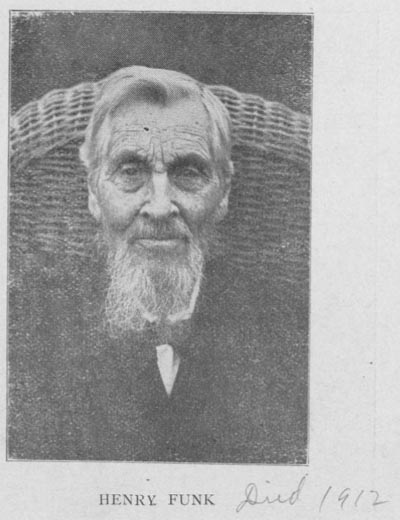
to the members of the Legislature which convened in
the old Court House when Corydon was the capital.
He went to Elizabeth when a young man, was married in
1832, and bought the farm on which he still lives.
He voted twice for W. H. Harrison and at every
Presidential election since.
DANIEL McRAE
Daniel McRae came to
Harrison County in 1814 and settled on the land where
New Middletown now stands. His son, Captain
John McRae, who died a year ago at the age of
eighty-five, was a well known steamboat man.
In 1863 he was captain of a steamer belonging to the
Marine Brigade which paroled the lower river to
seize "guerillas" who were devastating the country.
His home was on a farm near Evans' Landing.
In 1807 Robert Denbo settled a few miles south
of Corydon. His only neighbor was Samuel Boone,
three or four miles away, none other nearer than ten
miles. He had to go to the falls to mill.
Richard and Joseph McMahon settled in this
neighborhood in 1808.
JAMES TROTTER
James Trotter was
born in Armaugh County, Ireland, January first, 1811.
He emigrated to Baltimore in 1816 and came to Harrison
County in November, 1826, and settled near Lopp's
Landing on the farm where he now resides. Besides
his work as a farmer he made seventy-five trips on flat
boats down the river with products of his farm. He
was brought up a Presbyterian but there being no church
of this denomination in his vicini-
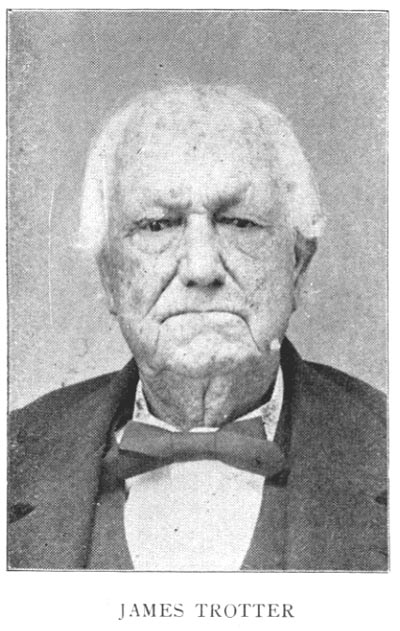
JAMES TROTTER
ty he joined the United Brethren church and assisted
in building a church which is still in use. He has
been a Sabbath School teacher for fifty years. His
present charge is the infant class which he supplies
with candy every Sunday. He is a public spirited
citizen and enjoys to the full the respect and
confidence of his neighbors.
WILLIAM M. SAFFER
Mr. Saffer was born
in Virginia and came with his parents to Harrison County
when a small boy. He was elected to the State
Legislature in 1853 on the Democratic ticket.
While there he was very active in the temperance cause
and helped to make Indiana a prohibition State in 1855.
He was the temperance candidate for Governor before the
convention which nominated A. P. Willard as an
anti-temperance candidate. Mr. Saffer was
beaten by one vote and Mr. Willard was afterwards
elected Governor.
He was a self made man and
took great pleasure in telling how he obtained the
little education he possessed. He was by no means
a learned man and occupying as he did, a prominent
position, was often the butt of jokers who undertook to
make fun of him; he was an Irishman though, with the
proverbial ready wit of his race and generally managed
to come
|
out ahead on such occasions. He was a local
Methodist preacher and a man of sterling worth.
Before the county had an asylum for the poor, Mr.
Saffer took charge of this class of the community on
his own farm in Webster township. He died Aprl
twenty-seventy, 1869, aged seventy-three years.
SOLOMON WINN
Solomon Winn
was born in Barren County, Kentucky, January twelfth,
1811. He emigrated to Baltimore in 1816 and came
to Harrison County in Blue River Township. The
town of Winnsboro was named after the elder Winn
who owned much land and gave the land on which
Thompson's
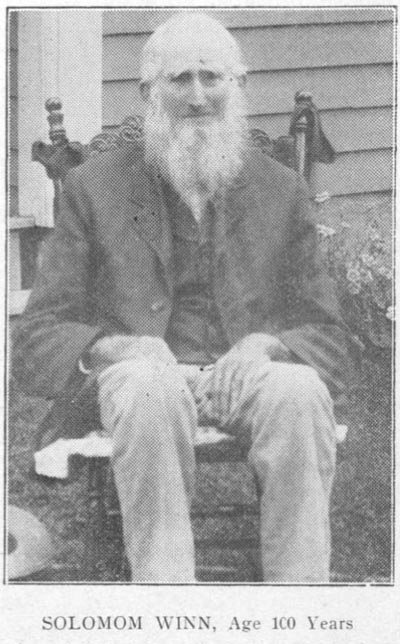 | |
SOLOMON WINN, Age 100 Years.
Chapel was built. Mr. Winn
remembers very much about the early years of Corydon, as
he frequently sold vegetables to the residents. He
will be 100 years old on his next birthday and bears his
years well.
JESSE SHIELDS
Jesse
Shields was probably the first person to settle in
Ripperdans Valley.
|
water. Pitman's cave has been explored two and a
half miles. It has an entrance like a well which
afterwards extends horizontally. Rhodes'
Cave is in the vicinity, and many others.
the Barrens, a section of country extending over
this and other counties for four hundred or five hundred
square miles, was made so by glaciers traversing the
section centuries ago. It is gradually growing up
in timber - wild plum bushes and oak and hickory
saplings.
The creeks of the county are not now put to use as in
former times. Mills were a great necessity to the
pioneers and every stream was lined with grist or saw
mills. By building dams a great amount of water
power was formed and half the litigation of those days
was about these mill dams. The power gained by one
man was often gained at the expense of his next neighbor
on the creek. Buck Creek was a good mill stream.
It is thirty miles in length, rises in the east of the
county and empties into the Ohio at Mauckport. Big
and Little Indian creeks were put to work also. At
one time there were forty-two mills on the creeks of
Harrison County.
Magnificent timber grew on the hills around, which has
been cut down without mercy. Poplar trees worth
fifty dollars a piece now, were given away to the owners
of saw mills to get them out of the way. Major
J. S. Pfrimmer has rails on his farm made out of
walnut trees ninety years ago.
The scenery along the river hills and about the streams
has been pronounced by competent judges to the
unsurpassed in beauty. Mr. Forsyth, an
artist of Indianapolis, and his pupils have spent
several autumn seasons here and in other places in the
county painting scenes which have found a ready sale.
This sketch should not close without mentioning the
Echo, equal to any in European mountains, which can be
heard on Big Indian creek near the bridge just west of
Corydon. Always distinct and musical, it is still
more so now after the peculiar whistle belonging to the
cold storage plant.
MORE PIONEER HISTORY
Squire Smith settled
on the Charley place in 1808. After him
Jacob Charley had a mill there. The house had
the usual big fireplace where the cooking was done.
People for miles around the country gathered there to
have their grinding done. They brought their own
victuals with them as, sometimes, they were obliged to
stay for days at a time before they could get their
grinding done.
Distilleries were everywhere, at convenient distances,
to work up the quantities of fruit for which the county
has always been famous. The first one on record
was built in 1816, but doubtless many were in operation
before that time. There was a distillery on the
Harrison farm. Our forefathers drank
unadulterated whiskey and entirely too much |
|
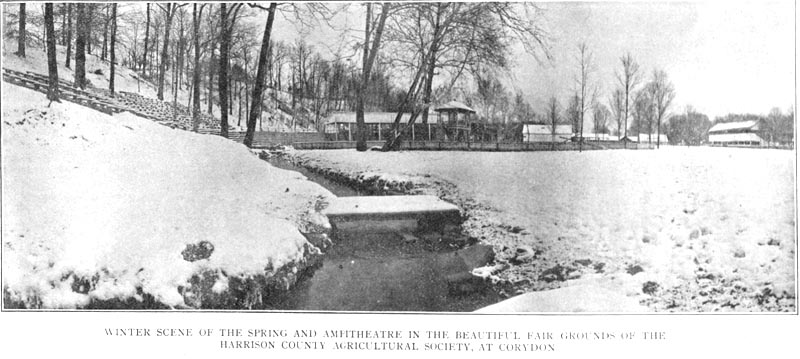
WINTER SCENE OF THE SPRING AND AMPHITHEATRE IN THE
BEAUTIFUL FAIR GROUNDS OF THE HARRISON COUNTY
AGRICULTURAL SOCIETY, AT CORYDON. |
|
The soil of Harrison County,
like all of Indiana, being far distant from the
primitive range of mountains is formed from the
destruction of a vast variety of rocks and sediment.
This has been blended by air and water and has all the
elements of extraordinary fertility. Especially
does this bear on the quantity and quality of the fruit
raised in the county. The flavor of the apples and
peaches raised here cannot be excelled. Elsewhere
is an account of some ancient apple trees growing on the
Harrison farm; these are not exceptional
but such cases are frequent over the county. There
is a pear tree growing on the farm formerly owned by
William Sonner near Valley City planted in 1819 and
still bearing fruit.
Harrison County abounds in springs, caves and openings
underground. It is scarcely possible to dig a
cellar or foundation to a house in the vicinity of
Corydon without reaching water. So cavernous is
the ground that in many places reverberations are heard
after ordinary footsteps that seem to indicate a
hollowness beneath. Numerous small caves are found
where the air is icy cold as in the case of the cave in
the vicinity of the Old Elm. Small caves and
running springs of water are at the bottom of several
wells. A case of this kind is found in the old
well in what is now a part of A. W. Brewster's
garden. This well was ever considered dangerous
and no one could be found to go down in it to clean it,
hence it was abandoned long ago.
Six miles west of Corydon is Wilson's Spring,
sixty feet in diameter. It has been sounded over
forty feet before the bottom was found. the Blue
Spring on the eastern edge of Corydon is a like
curiosity, although familiarity has robbed it of its
wonder. It pours out a limitless supply of
|
of it, but some excuse may be found in the hard life
they lived and the dangers and sickness to which they
were exposed. The "Millie Gwin" Hotel in
Lanesville, an old land mark still standing, was famous
in its day for the well filled whiskey bottle that
always stood on the mantle shelf.
As an offset to this it is pleasant to record that
churches built of logs sprang up in many a clearing.
It is useless to try in the short space this history
affords, to tell the self-sacrificing labors of the
pioneer ministry. They believed the groves were
God's first temples and for lack of church buildings
instituted a circuit of camp meetings where all could be
accommodated and where a fervent gospel was preached
without money and without price.
GHOST STORY
Between Lopp's
Landing and Mauckport a cabin was built long ago by a
boatman who landed, burnt a lime kiln and made ready to
go down the river with a load. Instead of this he
was murdered and robbed, his head cut off and his body
thrown into the river. At various times since then
this headless man as been seen in Haunted Hollow, as it
is called. It is a dreary, lonely spot and the
traveler instinctively hurries through having a feeling
that the "gobblins will git him if he don't watch out."
INDIAN STORY
Elizabeth Polk,
daughter of Colonel Polk, an old Indian fighter,
and wife of Spier Spencer, was stolen by the
Indians when a child. The father and brothers were
away from home after Indians when another party attacked
the house carrying away the women and children.
All were recovered except the little girl Elizabeth
to whom an old squaw had taken a liking. They were
obliged to get the British to negotiate with the Indians
and were able to get her back on payment of sixty
dollars. |
|
Pg. 45 - Industrial Review,
Biographies and Portraits of Leading Citizens. |
|
PIONEER CHURCHES AND MINISTERS.
Old Goshen Church in Boone
township is, without doubt, the oldest church in
Harrison County. It is standing just as it did
when Moses Boone and George Bartley cut
down the trees and hewed the logs on the spot and put up
the building in 1813. The cemetery adjoining has
moss grown tombstones almost a hundred years old,
bearing the names of Douglas, Boone and many
another well known pioneer and their descendants to the
third generation.
John George Pfrimmer, a United Brethren
preacher, organized all the early churches of that
denomination in the State. He built Pfrimmers
Chapel in 1818. The present church stands on the
old site.
James Armstrong, a Methodist preacher, came to
this county in 1800 and settled just below Lanesville.
He travelled and preached all over the State in school
houses and churches and at camp meetings.
Roger's Chapel in Posey township is among the oldest in
the county. Mr. Rogers and Mr. Potts,
the latter, father-in-law of Henry Funk, gave the
land and it was named for Mr. Rogers. The
first log house is gone and the present one stands in
the same place. Mrs. Rogers is
buried there.
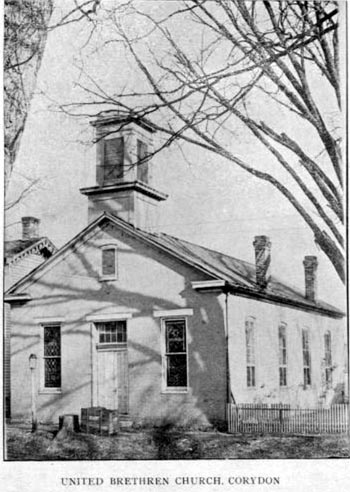
UNITED BRETHREN CHURCH, CORYDON.
The land for Thompson's
Chapel in Spencer township was deeded July thirty-first,
1824, by John Hughes to be used as a Methodist
Church and a schoolhouse. It was named for
William Thompson, a typical pioneer preacher, who
accepted just what people chose to give him for his
services. He had a buffalo overcoat that sheltered
him in rain or snow, or served as a saddle blanket while
riding. At night it was rolled up for a pillow and
its owner slept on the ground wherever night overtook
him.
A Dunkard church stood long ago near Bradford.
The cemetery is filled with tombstones with inscriptions
that date back a hundred years.
Levi Long was a noted Baptist preacher. He
was the son of a Revolutionary soldier and was born
about the time the war closed. While still a young
man he came to Indiana and began preaching. He
travelled over Kentucky, Indiana, Illinois and Ohio and
asked no pay for his services. His wife was a
charitable woman who managed to knit and give away four
or five dozen pairs of socks every winter. Her
husband seems to have ap-
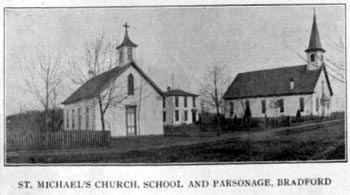
ST. MICHAEL'S CHURCH, SCHOOL AND PARSONAGE, BRADFORD
preciated her for he was wont to say "It's a good
thing everybody does not see alike or they would all
have wanted my Sukie."
Mr. Long helped to build the old State House and
when the corner stone was laid he put in some coins.
His ready assistance was given to help build nearly all
the Baptist churches in the county. He was buried
at Oak Grove.
The famous Republican meeting house was located in
Ripperan's Valley. the house was built by the
united efforts of the neighborhood in 1828 and answered
the double purpose of church and schoolhouse. It
was free to all denominations. The first Baptist
preachers were Revs. Lone, Armstrong and Levi
Long. Lutheran ministers were Henkle,
Reiser and Krack. Presbyterians were
Martin and Dubuar. Methodists were
Revs. Daniels and W. C. Smith. The
Methodists organized here about 1838 and in 1847 had the
first Sunday School, Aaron Bean Superintendent.
The first person buried on the church lot was Eli J.
Wright, son of Joel Wright. |
There are now over two hundred buried
there. The old church was sold about 1873 and
moved to New Amsterdam and the high water of 1884
carried it away.
The Christian Church building in Corydon was originally
a United Brethren Church. The ground was donated
by Dr. D. G. Mitchell. Rev. Lyman Chittenden
was the last preacher of that denomination who had
charge. this was in 1852. Soon afterwards it
was bought by a small membership of the Christian Church
and at different times has been renovated and improved
until 1903 when it took on its present handsome
appearance.
On the seventh day of September, 1826, Isaiah Boone,
son of Squire Boone, deeded to Thomas Highfill,
John Smith, Jacob Kintner, Jacob Hisey and
Benjamin Adams, trustees, the south half of lot
number forty-
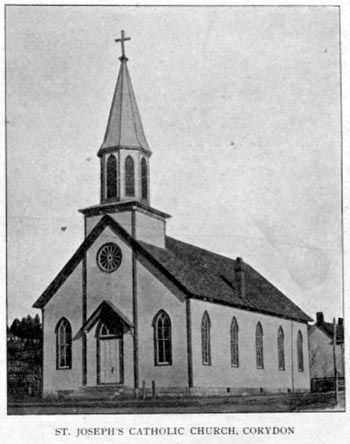
ST. JOSEPH'S CATHOLIC CHURCH, CORYDON
three in the town of Corydon to build a
house for the use of the Methodist church. This
building stood until 1859 when it gave place to a new
and larger one. This in turn was remodeled in 1902
and is now a commodious and beautiful structure.
It would be useless, in the short space of this history
to try to enumerate those who preached the word in this
old church. the Recording Angel can call their
names, although to earthly vision they may not appear on
any costly stone or monument of marble.
In 1810 Rev. Dr. Crowe of Hanover came to
Corydon and organized a Presbyterian church with Mr.
Armstrong and Henry Rice, father of John
Rice, as ruling elders. A small church was
built in 1819. Its earliest pastor was William
W. Martin, known as Father Martin. His
sons, D. N., Dr. William A. P. and Dr.
Claludius B. H. became ministers, the two former
going to China as Missionaries. When W. A. P.
Martin was born his father was absent from home at a
meeting of Presbytery. Word was sent
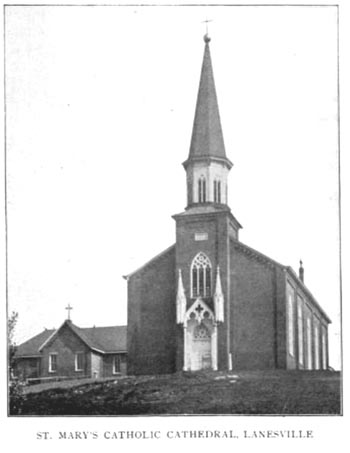
ST. MARY'S CATHOLLIC CATHEDRAL,
LANESVILLE.
him and he announced the fact to the
assembly and added "Here is a young missionary."
His words were prophetic. W. A. P. Martin
went to China and is still there an aged missionary.
For many years he has been President of the Imperial
College at Pekin and was a trusted advisor during the
Boxer uprising. Five of the seven daughters of
Father Martin married Presbyterian ministers.
Three brother-in-laws, Samuel, Thomas and
William A. P. Alexander were all ministers, the
latter being a missionary in the Sandwich Islands.
The first permanent pastor was Alexan-
|
der Williamson who came
to Corydon in 1824 and married Miss Lydia Rice in
1826. Mr. Williamson went in 1822 as
missionary to Mississippi. He died in Corydon in
1849 and is buried in Cedar Hill Cemetery. Mrs.
Eleanor Slemons, now living at the age of
eighty-six, the oldest surviving member, was baptised in
the old Court House before the church was built.
The Catholic Cathedral at Lanesville is one of the
finest churches in the State. The congregation
dates back to 1843 when Father Opperman on
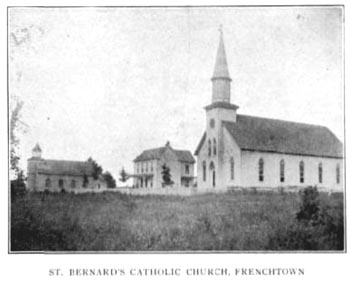
ST. BERNARD'S CATHOLIC CHURCH, FRENCHTOWN
his way to Oldenburg stopped to give
services to the few Catholic families there. These
services were held in an old dwelling just in front of
where the church now stands. At this time three
hundred and twenty-five dollars was paid for land on
which to build a church. The first church was
built in 1849 by Father Neyron. In 1854 Rev.
Alphonse Munshina took charge and provided a school
and a parsonage for the Sisters of Providence.
The first mission was preached at this place by
Father Weningerb in 1855. The magnificent
church which now stands was begun in 1856 and
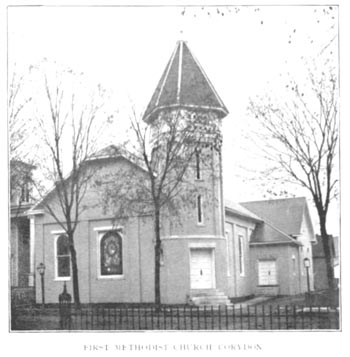
FIRST METHODIST CHURCH, CORYDON
occupied in 1860. It was
dedicated by Bishop de St. Palais in June, 1864.
Father Munshina was pastor for thirty-nine years
and was succeeded by Rev. A. Peckskamp in 1893
and who is still its pastor. Father Peckskamp
was born in Dama Oldenberg, Germany, August
twenty-ninth, 1849, and emigrated to America in 1860.
During Father Peckskamp's pastorate he has spent
over five thousand dollars on the interior decoration of
the church and built a magnificant brick school
building that cost about five thousand dollars more.
EARLY MANNERS
AND CUSTOMS
It may not
be amiss to recount some of the old time manners and
customs and to begin at the foundation: - it was not
possible at that early perriod to keep provided with
shoes, hence going barefooted was customary everywhere,
even in winter. Dr. G. D. Mitchell, a self
made man, went to school barefooted over the snow.
He carried a puncheon slab well heated and frequently
stopped to stand awhile on this to get his feet warm and
would then proceed on his way. The pioneers who
worshipped at Goshen Church dressed themselves in their
clean clothes and went to church bare-footed.
Mr. John Lane, now dead, was heard to say he never
had shoes when a boy but ran over the ice and snow as
nimbly as if well shod.
The wild grass, mast and roots were so abundant in the
woods that hogs, cattle and horses required little other
food. the farms consisted most of cornfields.
Hogs ran wild and had to be marked or they would house
to defend the rights of the owners. It is amusing
to read descriptions of some of these marks.
Fires were lighted with a tinder box or two hard
substances rubbed together until a spark would be
engendered which set fire to inflammable
|
|
Pg. 46 - Industrial Review,
Biographies and Portraits of Leading Citizens. |
|
CORYDON BEAUTIFUL |

RESIDENCE AND OFFICE OF DR. Z. C. WOLFE |
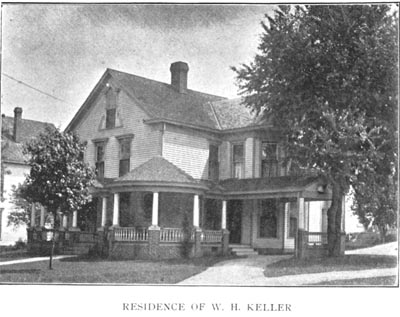
RESIDENCE OF W. H. KELLER |
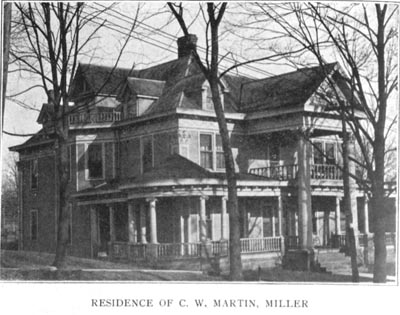
RESIDENCE OF C. W. MARTIN, MILLER |
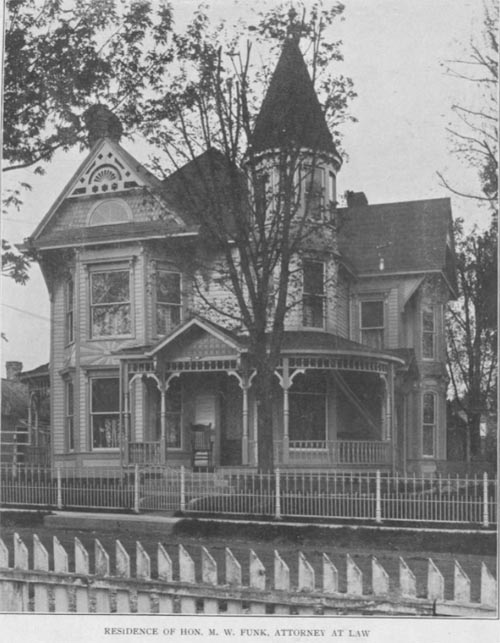
RESIDENCE OF HON. M. W. FUNK, ATTORNEY AT LAW |
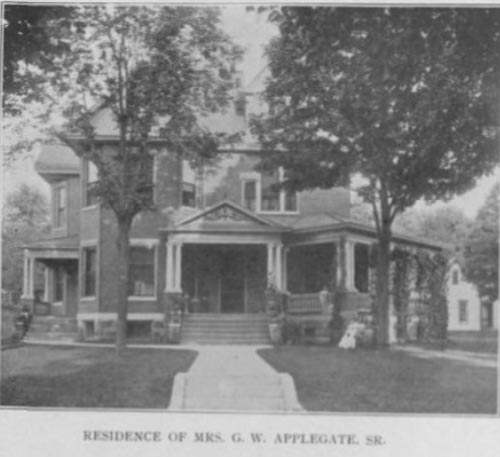
RESIDENCE OF MRS. G. W. APPLEGATE, SR.

RESIDENCE OF DR. JNO. E. LAWSON |
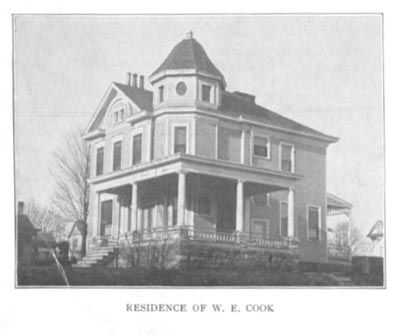
RESIDENCE OF W. E. COOK |
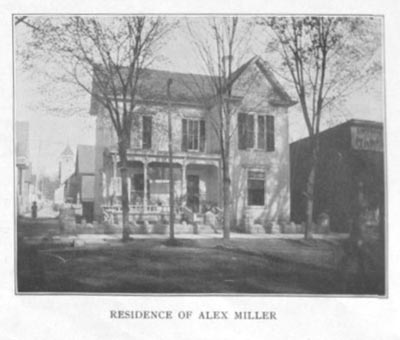
RESIDENCE OF ALEX MILLER |

RESIDENCE OF JAS. W. McKINSTER, RETIRED |
|
Pg. 47 - Industrial Review, Biographies
and Portraits of Leading Citizens. |
|
THE TEACHERS OF SPENCER TOWNSHIP.
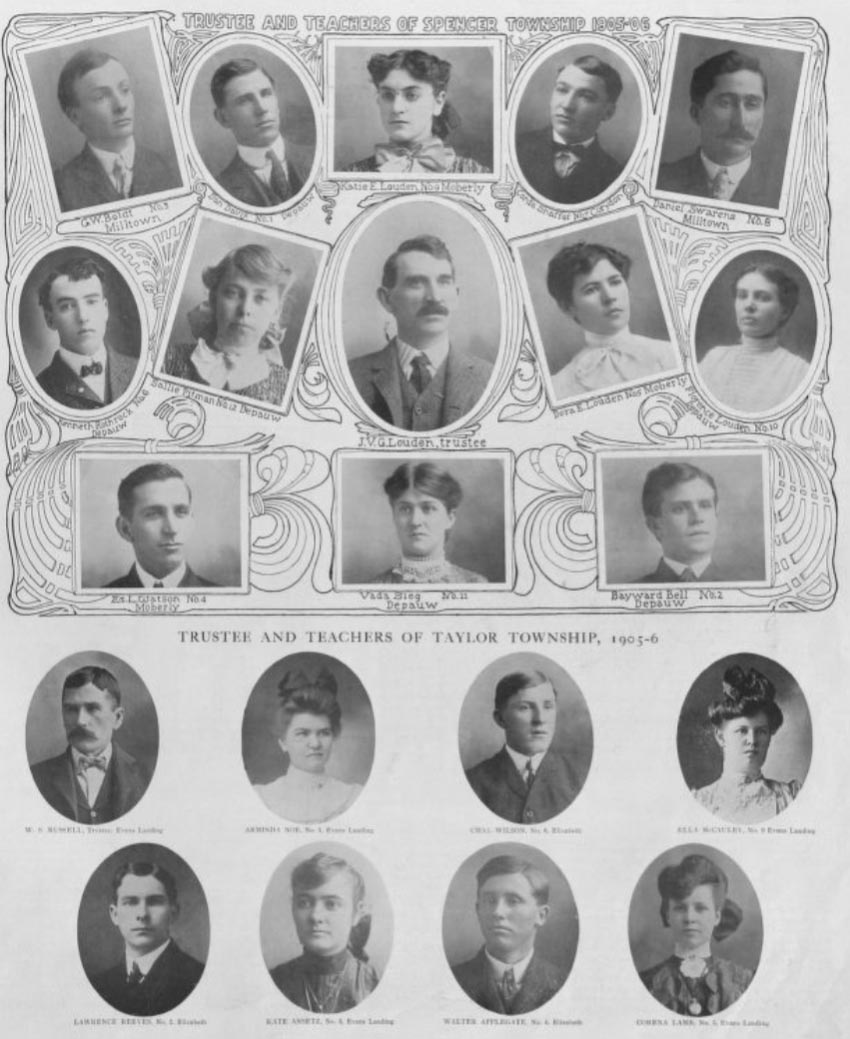
Top Row:
G. W. Boldt, No. 3, Milltown
Dan Davis, No. 1, Depauw
Katie E. Louden, No. 9, Moberly
Corda Shaffer, No. 7, Corydon
Daniel Swarens, No. 8, Milltown
Next Row (2nd from top)
Kenneth Rothrock, No. 6, Depauw
Sallie Pitman, No. 12, Depauw
J. V. G. Louden, trustee
Dora E. Louden, No. 5, Moberly
Florence Louden, No. 10, Depauw
Next Row (3rd from top)
Ed. L. Watson, No. 4, Moberly
Vada Sieg, No. 11, Depauw
Bayward Bell, No. 2, Depauw
TRUSTEE AND TEACHERS OF TAYLOR
TOWNSHIP, 1905-6
Next Row (4th from top)
W. S. Russell, Trustee, Evans Landing
Arminda Noe, No. 1, Evans Landing
Chas. Wilson, No. 6, Elizabeth
Ella McCauley, No. 9, Evans Landing
Next Row (5th from top)
Lawrence Reeves, No. 2, Elizabeth
Kate Ansetz, No. 3, Evans Landing
Walter Applegate, No. 4, Elizabeth
Corena Lamb, No. 5, Evans Landing
|
|
Pg. 48 - Industrial Review, Biographies
and Portraits of Leading Citizens. |
substances. In winter the fires were carefully
covered up at night to preserve coals. If there
were no coals left it was not usual to have to go to a
neighbor for a shovelful of coals or a burning chunk or
brand of fire.
Grain was thrashed with a flail as late as 1840.
Salt was hard to get, the nearest market for it being
Louisville. It was evaporated in shells or bark of
trees by the Indians at the salt licks near Lanesville.
Cooking was done at the fireplaces and once more the
writers recollection goes back to a big spare rib
suspended in front of the fire which it was her duty to
keep turned ever and again to roast both sides while the
grease dripped into a pan below, or at other times to
keep fresh coals on top of the iron oven lid, inside of
which the corn bread was baking.
Abe Lincoln's experience of studying by
firelight was no new thing to the dwellers in Corydon,
who as early as possible advanced to lard lamps and
tallow candles and hailed with delight the coming of
kerosene with its splendor.
Window glass was a rarity in 1810. Greased paper
served the purpose. Governor Jennings was a
politician who believed in keeping his name before the
public and old residents said his name could be seen in
the paper sashes of every schoolhouse. He also
helped to build log houses and mow in the fields.
Mr. Frederick Doll, who came to the county in an
early day, has said that he used to haul hay to Corydon
for Governor Jennings when the latter was the
State's Chief Executive. He said that the Governor
would assist him in unloading the hay and was quite
familiar with him, and frequently would crack a joke or
two.
Mr. Giles, "Uncle Jimmie" as everybody
called him, used to exhibit an old cherry sideboard
which he owned and had at his house. He said that
this piece of furniture had been formerly owned by
Governor Jennings when he was Governor of the
States; that the latter had drunk many a glass of "grog"
from that same sideboard. Governor Jennings
became intemperate, which greatly impeded his usefulness
in later life.
Women used to piece quilts and work their samplers.
They dressed their own wild turkeys for their wedding
dinners and embroidered their own wild turkeys for their
wedding dinners and embroidered their own wedding gowns.
Bear, fix and coon hunts were a recreation among the
men. wolves were so plentiful that they sat in the
open road as children went to school and a bounty was
paid for every wolf scalp. At one time a bear was
tracked to his den by Henderson Stevens and two
neighbor boys named Foster and Arnold.
It was its cave so far that only the glitter of its eyes
could be seen by the light of a lantern. Young
Arnold was let down with a rifle in his hand and his
feet held by the other two, and in this position he shot
the bear. |
MURDER OF WILLIAM GRESHAM
In January, 1834, a disturbance arose in the Sipes
neighborhood, near Blue River township. Levi
Sipes, a young man, became enraged over a whipping
given his brother in school and grew so unruly that the
local authorities were not able to manage him.
They sent for the County Sheriff, William Gresham,
that he might arrest him. Sipes shot Mr.
Gresham and afterwards slashed him with a knife.
The body of Gresham was prepared for burial and
brought to Corydon and afterwards taken to his home near
Lanesville. Sipes was tried at the April
term of Court, 1835, and was defended by Honorable
John Rowan, of Louisville, Kentucky.
Charles Dewey was prosecuting attorney. The
jury returned a verdict of manslaughter and punishment
fixed at twenty-one years in penitentiary and one
thousand dollars fine. Sipes was pardoned
by the Governor after having served four or five years
imprisonment and his fine was remitted.
During the September term of court in 1850 St. Clair
Young was shot and killed at the Jameson
boarding house in Corydon by William C. Marsh.
Mr. Young's son had married a daughter of Mr.
Marsh and family troubles had followed until the two
were bitter enemies. At the dinner table that
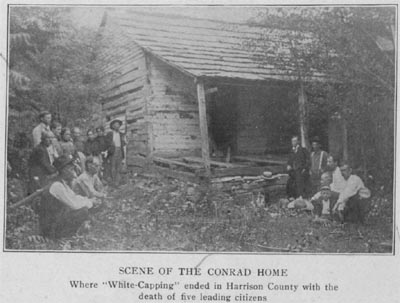
SCENE OF THE CONRAD HOME
Where "White-Capping" ended in Harrison County with the
death of five leading citizens.
|
MURDER AT MAUCKPORT
In the summer of 1854
Reuben Williams killed Benjamin Miller at
Mauckport. Williams had, prior to the
killing, been employed by Miller to work in his
mill. They had a difficulty and Williams
was discharged. It was believed that Williams
slipped up behind Miller while he was at work and
struck him on the head with a hatchet. Williams
was tried and acquitted by a jury and made his escape
from Mauckport immediately.
the following account of the Indiana White Caps is
condensed from an article published in a Pennsylvania
paper and prepared by George C. Irwin of the
Democratic office: The first case of White Capping
was the flagellation of James Keen in 1868.
He was accused of stealing from his neighbors in Scott
township. He returned to Kentucky.
THE "WHITE CAPS"
In 1873 there came into
existence a secret organization known as the "Harrison
County Regulators", a society which had signs, grips,
passwords and binding obligations. The name "White Caps"
was suggested by the white hoods worn by them as a
disguise. Each council had two officers - a
captain and a lieutenant, and their place of meeting was
in some sequested spot at midnight. At these
meetings they heard reports from committees of
investigation and decided on the punishment for alleged
misdemeanors. The members were then provided with
strong hickory switches, and, upon command of the
captain the company galloped away on its mission of
vindicating the offended law.
Within the next few years over twenty cases of White
Capping occurred. The number of lashes given was
usually fifty but sometimes as many as seventy-five were
given. It was useless to appeal to the courts for
nothing could ever be proved against the accused
Regulators.
The first sacrifice of life in these hazardous White
Cap operations was in Blue River township on the night
of April twenty-sixth, 1880. Henry Long was
termed a "jack leg lawyer" and accused of stirring up
strife in the neighborhood. He was a man of well
known courage and they resorted to a ruse to avert
danger to themselves. They had him arrested on a
trumped up charge and the trial set at night with a long
array of witnesses to prolong it until a late hour.
The trial was proceeding before Squire Archibald
Boston when the Regulators appeared. Long had
been disarmed but a friend had managed to slip him a
revolver. He sprang to the door and shot the first
masked man who entered. He lived but a short time
and p[roved to be Louis Hen-
|

NORTH MARKET STREET SCENE, CORYDON |
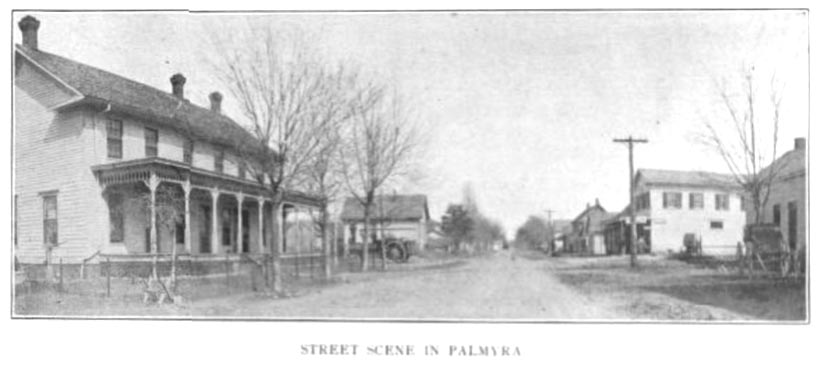
STREET SCENE IN PALMYRA |
|
|
Another story is of a
squirrel hunt in 1825l to which a prize added zest.
Captain William Heth and Captain Isaac Sonner
headed each a band of twenty-five men and they were to
capture as many squirrels as possible, the prize to go
to the band having the greatest number. A
difficulty arose over the matter and a fight ensued in
which Captain Heth came out second best.
INDIANS
Until the close of the territorial government
three-fourths of the state was in possession of the
Indians. By treaties with them the bounds of the
Vincennes tract were laid so that its survey might be
made. The Delawares and Piankeshaws were the last
to cede. the Indian trail running diagonally
across the north of Harrison County on Indiana maps
shows a portion of this boundary. The Indians
still roamed around when Corydon was a town of three
houses but they were generally friendly. A party
of them visited the cabin of Edward Smith and
found only the children at home, the parents being on a
visit in Lanesville, the nearest neighborhood. The
Indians gave the children some ornaments made of shells
and departed peacefully. At another time Dr.
English, whose sisters had married respectively
Dennis and William Pennington, was visiting Mr.
Smith. He, with his sisters, in their youth,
had been held in captivity by the Delaware Indians.
It happened that a party of Delawares were camping where
Mauck's Mill afterwards stood and by some means
heard of Dr. English's presence so near.
They threatened his recapture and he became alarmed.
With the guidance of some of Mr. Smith's family
he went away and never returned.
DEEDS OF VIOLENCE In 1812
Colonel Posey was Pension Agent. A
pensioner named White came to town to draw his
pension and stopped at the Spencer House where a
stranger named Cooley was staying. In the
evening these men went out together for a good time and
White got very drunk. In the morning he
found his money gone and suspician was at once laid on
Cooley. Some of the citizens, Tipton,
Mefford, Fred Kintner, Vigus and others, tried to
get him to confess but failed, whereupon they took him
out and whipped him. After many strips to no
purpose, Tipton remarked "We will be prosecuted
anyhow, so let's wear him out." Some of the crowd
started off for more switches and while they were gone
the culprit confessed and told where he had secreted the
money. It was found and given to the owner and the
culprit allowed to depart. This is the first
affair of this kind on record. |
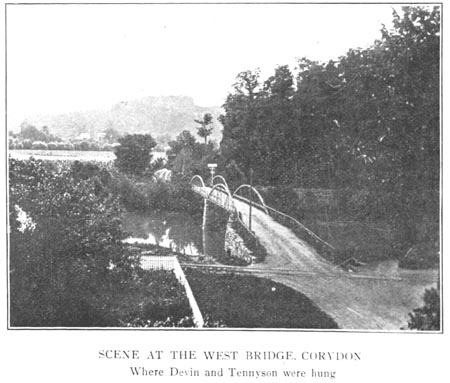
SCENE AT THE WEST BRIDGE, CORYDON
Where Devin and Tennyson were hung
day the quarrel was renewed and Young threw a
fork at Marsh when Marsh drew a revolver and shot
him dead.
This case came up for trial April thirteenth, 1852,
with W. T. Otto, Judge and G. A.
Bicknell, Prosecutor. Lawyers for prosecution
were Ben Hardin of Kentucky, Charles Dewey,
James Collins, Jr., and S. K. Wolfe.
For defense were R. Crawford, W. A. Porter, H. P.
Thornton, A. P. Willard, S. H. Keene and D. W.
Lafollette. Jurors were William Hancock,
Jonathan P. Cole, Isaac Pitman, George Wright, Wm.
Evans, W. M. Bruce, James Wright, Oliver W. Littell,
William Wright, John R. Horner, William Wright and
Craven Lynn.
The case was around for
prosecution by Dewey and Hardin and for defense
by Porter and Keen. Marsh was
acquitted. A few years after, in 1858, during a
term of court at Brandenburg, Mr. Marsh was
standing on the steps of a hotel in that town when
Stanley Young, a son of St. Clair Young, went
out on the top of a veranda nearby, shot him dead and
made his escape. He was never captured and it is
supposed he entered the Southern army and was killed.
|
riott, a leading citizen of the
township. After the first shot the revolver failed
to work or he would no doubt have succeeded in selling
his life more dearly. Almost miraculously he
escaped from the mob, not, however, before receiving a
shot in the head that resulted in his death a few days
later.
THE HANGING OF DEVIN AND TENNYSON
At twelve
o'clock at night, June twelfth, 1889, one hundred and
fifty horsemen rode into Corydon and a few minutes later
James Devin and Charles Tennyson had been
taken from the jail and were dangling at the ends of
ropes from the girders of the bridge just west of town.
The crime for which they expiated their lives was as
follows: Friday, June seventh, 1889, James
Devin and Charles Tennyson went to the home
of James Lemay, four miles northeast of Corydon,
ostensibly as stockbuyers. They were given supper
and while eating they kept looking about the room in a
suspicious manner. Mr. Lemay noticed this
and armed himself with a revolver.
The men were told their room was ready and they could
retire when they wished, one of them drew a revolver and
ordered the family, consisting of Mr. Lemay and
his wife, his two neices and a hired man, into a room
and shut the doors. When the doors were closed
Mr. "Lemay reached for his revolver and the man
nearest him commenced shooting. A continuous
firing was kept up between them.
Mr. Lemay fired three shots and was wounded five
times, and Miss Lucy Lemay was wounded in the
arm. After emptying his revolver Devin ran
out the door and Tennyson went headforemost out
of the window. Miss Matilda Lemay ran out
and rang the farm bell for help, but the men had
escaped. They were captured next day at New Albany
and brought to Corydon and placed in jail. Their
punishment followed as above described.
THE "WHITE CAP" DRAMA ENDS.
The closing
scene in this White Cap drama was enacted in "Conrad's
Hollow" near the source of Mosquito Creek in Boone
township, Saturday night, August fifth, 1893. In a
cabin in this Hollow, Sam and Bill Conrad lived
with their mother and sister. The father,
Edward Conrad, had been found in a dying condition a
few hundred yards from his door some months prior to the
above date and suspicion of murdering him rested on the
two sons. They were tried in Corydon but no proof
being found against them they were discharged from
custody.
|
|